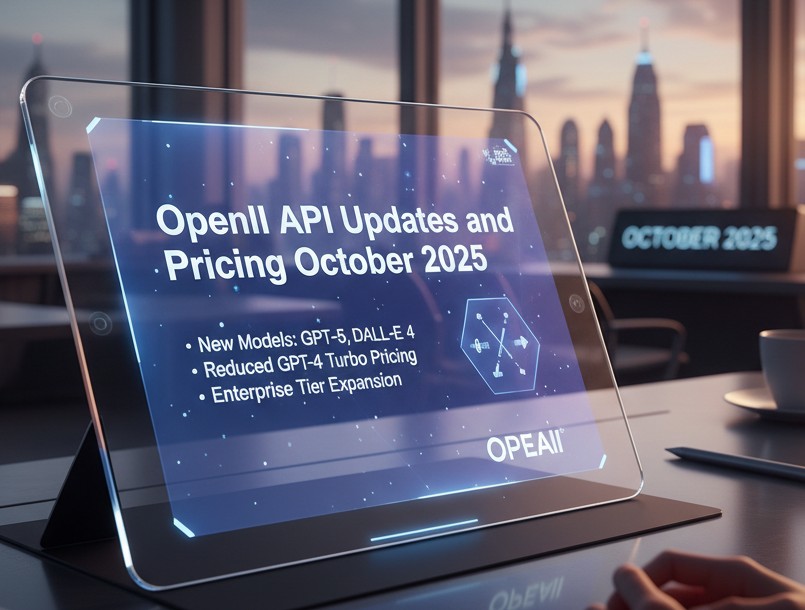
OpenAI API Updates and Pricing October 2025
A Deep Dive into OpenAI’s October 2025 API Pricing & Model Updates**
The AI landscape is evolving at a breakneck pace, and OpenAI’s latest 2025 API update marks one of its most significant shifts yet. Moving beyond a one-size-fits-all approach, the release introduces a sprawling family of specialized models, each designed for specific tasks and budgets.
For developers, product managers, and entrepreneurs, understanding this new structure is crucial for building cost-effective and powerful applications. Let’s break down everything you need to know.
The Headliners: Introducing the GPT-5 and GPT-4.1 Families
OpenAI has officially unveiled the GPT-5 series, positioning it as the new flagship for coding and “agentic” tasks that require complex, multi-step reasoning.
- GPT-5: The powerhouse. With pricing at $1.25 per million input tokens and $10 for output tokens, it’s designed for the most demanding, high-performance applications across industries.
- GPT-5 mini: A balanced option for well-defined tasks. At $0.25 (input) and $2.00 (output), it offers a 80% cost reduction for input compared to GPT-5, making it an excellent default for many agentic workflows.
- GPT-5 nano: The new budget champion. For simple summarization and classification, its price of $0.05 (input) and $0.40 (output) per million tokens makes it incredibly accessible for high-volume processing.
Alongside GPT-5, the GPT-4.1 family receives dedicated fine-tuning support, providing a more advanced and cost-effective path for customizing models beyond GPT-4o.
The Rise of Specialized Models: Realtime, Audio, and Vision
A key theme for 2025 is specialization. Instead of a single model trying to do everything, OpenAI is launching dedicated endpoints.
1. The Realtime API Designed for low-latency, conversational experiences like voice assistants and live customer support, the Realtime API has its own model family and pricing.
- gpt-realtime (Text): $4.00 (input) / $16.00 (output)
- gpt-realtime (Audio): $32.00 (input) / $64.00 (output)
- GPT-4o-mini-realtime-preview: A cheaper alternative at $0.60 (text input) / $2.40 (text output) and $10.00 (audio input) / $20.00 (audio output).
2. Image Generation & Understanding
The new gpt-image-1 model is the successor for high-fidelity image creation and editing.
- Understanding: Processing images costs $10.00 per million input tokens.
- Generation: Image outputs are billed per image, with cost varying by quality and size:
- 1024x1024: Low ($0.011), Medium ($0.042), High ($0.167)
- This provides a more granular pricing structure compared to the fixed rates of DALL-E 3.
3. Dedicated Audio Models Beyond the Realtime API, standalone audio models are available for transcription and speech generation (TTS).
- Transcription (Whisper): Remains at $0.006 per minute.
- Text-to-Speech (TTS): $15.00 per million characters (Standard) and $30.00 for TTS HD.
Fine-Tuning Gets a Major Overhaul
Fine-tuning is now more accessible and transparent, with clear pricing for training and inference on customized models.
- o4-mini: Reinforcement fine-tuning costs $100 per training hour, with inference at $4.00 (input) and $16.00 (output). Enabling data sharing cuts inference costs by 50%.
- GPT-4.1 Fine-Tuning: Training costs a one-time fee per token ($25.00 for GPT-4.1), with tuned models then available at higher inference rates than their base versions.
- GPT-4o-mini Fine-Tuning: An incredibly cost-effective option at $3.00 for training and $0.30/$1.20 for input/output inference.
Expanded Reasoning Models (o-Series)
The o-series for “reasoning” has expanded into a full-fledged product line, catering to different needs and budgets.
- Top Tier:
o1-pro($150 input / $600 output) for the most complex problems. - Mainstream Reasoning:
o1($15 input / $60 output) ando4-mini($1.10 input / $4.40 output). - Deep Research: Specialized variants like
o3-deep-researchando4-mini-deep-researchare available for tasks requiring deeper computation.
Built-in Tools: Clearer Cost Attribution
The cost of using built-in tools is now more explicit, helping developers forecast expenses accurately.
- Code Interpreter: $0.03 per session.
- File Search: $0.10 per GB per day for storage, plus $2.50 per 1,000 tool calls.
- Web Search: $10.00 per 1,000 calls (for reasoning models) + the tokens from the search content are billed at your model’s input rate. For some mini models, search content is charged as a fixed block of 8,000 input tokens per call.
Legacy Models & Embeddings
Older models remain available but are generally less cost-effective. The embeddings market is now dominated by text-embedding-3-small at just $0.02 per million tokens, with a 50% discount for batch processing.
Strategic Implications: What This Means for You
- Cost Optimization is King: The massive price difference between model tiers (e.g., GPT-5 vs. GPT-5 nano) means that “right-sizing” your model choice is the single most important factor in controlling costs. Use the cheaper models for simpler, high-volume tasks.
- Specialization Drives Efficiency: For specific modalities like realtime audio or image generation, using the dedicated models will yield better performance and potentially lower costs than forcing a general-purpose model to handle the task.
- Fine-Tuning is a Viable Path: With clear and more competitive fine-tuning prices, creating a custom-tuned model for a specific use case is now a realistic option for more businesses, especially using the
gpt-4o-miniorgpt-4.1-minias a base. - Plan for Tool Costs: Don’t overlook the cost of built-in tools. A high-volume application using File Search and Web Search can see significant additional charges on top of the model inference costs.
Conclusion
OpenAI’s 2025 update is a maturation of the API ecosystem. It’s no longer just about raw power; it’s about choice, specialization, and cost-efficiency. By carefully selecting from this new menu of models—from the formidable GPT-5 to the ultra-lean GPT-5 nano, and from the realtime specialists to the fine-tunable GPT-4.1 family—developers can build more sophisticated and economically sustainable AI-powered products than ever before.
Always refer to the official OpenAI Pricing Page for the most current and detailed information.

